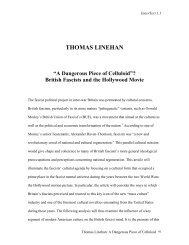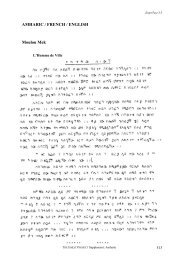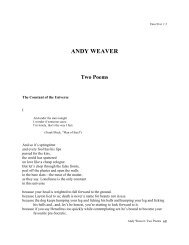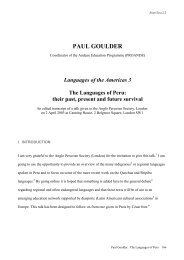Thomas Lamarre: An Introduction to Otaku Movement - Arts @ Brunel
Thomas Lamarre: An Introduction to Otaku Movement - Arts @ Brunel
Thomas Lamarre: An Introduction to Otaku Movement - Arts @ Brunel
You also want an ePaper? Increase the reach of your titles
YUMPU automatically turns print PDFs into web optimized ePapers that Google loves.
EnterText 4.1<br />
If Kubo and Tanaka succeed, it is because of their youthful passion for anime—which<br />
may happen <strong>to</strong> any man at any age anywhere. Their triumph provides one positive image<br />
of difference. Nonetheless, as the stark visual difference between the mockumentary and<br />
animated segments suggests, these two kinds of self-differentiation remain in dialectical<br />
tension—one cannot overcome the other, but neither can one work without the other.<br />
The dialectical tension in <strong>Otaku</strong> no Video becomes condensed in<strong>to</strong> the problems<br />
of au<strong>to</strong>eroticism and fetishism. Its emphasis on play over disciplinary knowledge enables<br />
self-cultivation, but this way of knowing one’s self takes the form of playing with one’s<br />
self—which is presented, quite literally in some segments, as masturbation. <strong>Otaku</strong> no<br />
Video hovers between the thrill and shame of playing with one’s self—or is it sex with an<br />
image? In either case, the act of masturbation condenses the dialectical tension between<br />
the negative and positive self-differentiation of the otaku. It is not so surprising that sex<br />
should come <strong>to</strong> the fore. After all, doesn’t sex also fall between work and play, socially,<br />
at once the site of social reproduction and self-production? What is troubling about <strong>Otaku</strong><br />
no Video is its relation <strong>to</strong> women. The thrill and passion it attributes <strong>to</strong> modelling and<br />
collecting girl figurines derives from a sense of au<strong>to</strong>nomy from real women and thus<br />
from social expectations associated with relations with them (work <strong>to</strong> provide the<br />
financial support necessary <strong>to</strong> marriage and family). <strong>Otaku</strong> no Video insinuates a sense of<br />
shame and failure in the inability of the otaku <strong>to</strong> interact with real women—with a sense<br />
of shame at social failure. In this dialectical tension between thrill and shame, between<br />
self-affirmation and self-negation, real women come <strong>to</strong> embody a condition of<br />
(im)possibility for manhood. Ultimately, otakuology seems only <strong>to</strong> imagine constituent<br />
power (and strategies of refusal) through recourse <strong>to</strong> male potency as an au<strong>to</strong>nomous<br />
<strong>Thomas</strong> <strong>Lamarre</strong>: <strong>Otaku</strong> <strong>Movement</strong> 174










